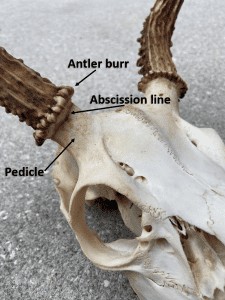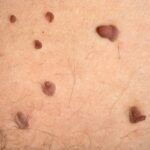Deer antlers are undeniably captivating. Their intricate shapes and impressive size spark curiosity and wonder. For those who have witnessed a majestic buck in its prime, the allure of antlers is unmistakable. This fascination stems from their unique nature in the animal kingdom, each set distinct, and their annual life cycle a remarkable physiological phenomenon. So, the question remains: why do deer, specifically whitetail bucks, shed their antlers each year?
As winter approaches, many venture into woodlands, eagerly searching for shed antlers. To truly appreciate these natural treasures, we must look beyond their form and delve into the biology of the animal that grows them, asking “how” and “why.”
Antler shedding marks the end of one antler’s life cycle and the beginning of the next. Shed antler hunting has gained immense popularity, with readily available resources guiding enthusiasts on how to find these prized possessions. However, beyond the hunt, intriguing questions arise: “Why do deer grow antlers instead of horns?”, “Why might a buck shed its antlers early?”, and “What biological mechanisms cause antlers to shed?” Let’s explore the answers to these questions and gain a deeper understanding of this natural wonder.
Why Antlers and Not Horns? The Biological Distinction
Antlers and horns, though both head adornments, are fundamentally different in their composition and life cycle. Firstly, antlers are made of solid bone, a stark contrast to horns which possess a living bone core encased in a sheath of keratin – the same protein that forms our fingernails. With the exception of pronghorn in North America, horned animals retain their horns throughout their lives, whereas deer shed and regrow their antlers annually. Furthermore, antlers are characterized by branching forks, a feature generally absent in horns. Lastly, horns grow from their base, with the oldest material at the tip, while antlers exhibit tip growth during their velvet stage.
Antler growth is a rapid process, primarily occurring from late spring through summer. A deer’s body prioritizes antler development, drawing minerals from its skeleton. This means bucks experience a temporary state of osteoporosis each summer as their bodies divert skeletal minerals to fuel antler growth. During the off-season, these mineral reserves are replenished in the skeleton. This internal mineral mobilization is crucial because a deer’s digestive system cannot absorb minerals quickly enough to meet the intense demands of antler growth – the fastest tissue growth observed in any mammal.
This annual undertaking of growing several pounds of bone on their heads, only to discard them after a few months, appears energetically wasteful. In the animal kingdom, energy is paramount to survival and reproduction. An animal must consume more energy than it expends to survive and, crucially, to reproduce. This leads us to the core question: why do deer invest in growing antlers yearly, instead of having permanent, energy-efficient horns?
The prevailing scientific theory suggests that antlers, unlike horns, serve as a more sensitive indicator of a buck’s health and fitness. From a biological perspective, it’s crucial for a doe to mate with a healthy and genetically robust buck. This maximizes the chances of producing thriving offspring, ensuring the continuation of her lineage and the species. Antlers facilitate this process through several mechanisms. Larger antlers are significant in dominance displays and sparring contests between bucks, influencing social hierarchy and ultimately, breeding opportunities. Moreover, recent research from the Mississippi State Deer Lab indicates that does, when given a choice, preferentially select to mate with bucks possessing larger antlers over those with smaller antlers.
While horn size could potentially serve similar purposes in sparring and mate selection, as seen in other horned animals, antlers offer a more dynamic and responsive cue to a buck’s condition. For example, if a buck sustains bone fractures from an injury, its body will prioritize healing the skeleton, diverting resources away from antler growth. Consequently, a buck in such a compromised state will grow significantly smaller antlers than it would if in peak health and with ample skeletal resources for antler development.
Conversely, if a buck breaks a main antler beam during a fight, it will regenerate a completely new set of antlers the following season. Horns, however, do not regrow. If deer possessed horns, a buck with a broken horn would be permanently disadvantaged. In both scenarios – injury-induced smaller antlers and antler regeneration after breakage – antlers prove superior to horns in reflecting a buck’s current fitness. A sickly buck will display smaller antlers, while a healthy buck, even with a past antler injury, can regrow a full set, providing accurate signals of their health status.
In essence, antlers serve a critical role in a buck’s life, far beyond being mere trophies for hunters. They are essential tools for sparring, defense against predators, and a visual display of fitness and dominance crucial for reproduction.
Testosterone: The Antler Growth and Shedding Regulator
The entire antler cycle – growth, mineralization, velvet shedding, and eventual antler shedding – is orchestrated by the hormone testosterone. Rising testosterone levels in late summer initiate antler mineralization and subsequently trigger the drying and shedding of the velvet. Testosterone reaches its peak during the rut (breeding season), leading to characteristic rutting behaviors: swollen necks, heightened aggression, and a shift in focus from feeding to breeding. Following the rut, bucks have typically lost considerable weight, and their priorities shift back to replenishing energy reserves through feeding. As testosterone levels decline post-rut, the antler shedding process is initiated.
While testosterone is the direct hormonal trigger for these antler and breeding cycle events, its levels are themselves regulated by other factors. The primary regulator of a whitetail’s annual cycle is sunlight. Photoperiod, or day length, acts as the environmental cue that signals a buck’s body to adjust testosterone production and a doe’s body to prepare for breeding. Therefore, the ultimate environmental cue driving antler shedding is the decreasing day length as winter approaches.
However, external factors can also influence testosterone levels and, consequently, antler shedding timing. Delayed breeding opportunities, for instance, can prolong elevated testosterone levels. “Late breeding does” can result from unsuccessful initial egg implantation, a doe fawn reaching sexual maturity later in the season, or occasionally a doe that was not bred during the peak rut. If breeding opportunities persist, healthy bucks will maintain higher testosterone levels to capitalize on these opportunities.
Conversely, a buck experiencing poor health or injury may undergo a sudden drop in testosterone levels. This can occur due to events like vehicle collisions, non-fatal gunshot wounds, or injuries sustained during sparring. In such survival-mode scenarios, a buck’s body prioritizes resource conservation over reproduction. This physiological stress triggers a rapid decline in testosterone, which in turn can lead to premature antler shedding. Thus, instances of bucks shedding antlers as early as November or December often indicate underlying health issues or significant stress.
The Mechanics of Antler Shedding: Osteoclasts at Work
We understand that declining testosterone levels, ultimately driven by photoperiod, initiate antler shedding. But how exactly do antlers detach from the skull? The mechanism is intricate and another fascinating aspect of antler biology.
On a buck’s skull, bony protrusions above each eye sockets are called “pedicles.” These pedicles are permanent parts of the skull and serve as the attachment points for antlers. At the base of each antler is the burr, a bony ring that acts as a protective shield where the antler meets the pedicle and skin.
Specialized cells called “osteoclasts” accumulate at the antler base, between the burr and the pedicle. Osteoclasts are responsible for bone resorption or breakdown. As testosterone levels decrease, these osteoclasts become activated and begin to erode the bone tissue at the interface between the pedicle and the antler base. This area of bone breakdown is called the “abscission line.” The abscission line weakens progressively until it can no longer support the antler’s weight, and the antler detaches and sheds. A shed antler base exhibits characteristic tiny pits, remnants of the abscission line. After shedding, a scab forms over the exposed, vascular pedicle, and the cycle of new antler growth begins anew the following spring.
Nature’s Remarkable Bone Trophies
Antlers rightfully deserve the fascination they inspire in both hunters and nature enthusiasts. Encountering a buck in full antler glory or discovering its shed antlers is an opportunity to appreciate the complex biological processes that create these extraordinary natural trophies. As you explore the woods in search of shed antlers, remember the remarkable story behind their growth and shedding – a testament to the intricate wonders of the natural world.
Adapted from information provided by Moriah Boggess, Deer Biologist with North Carolina Wildlife Resources Commission.

